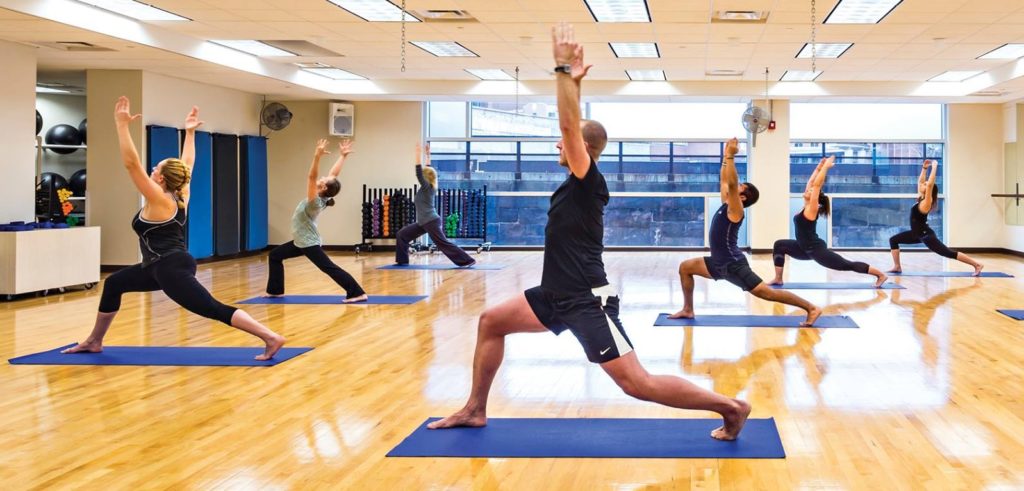by Michelle Sutton-Kerchner
Chilly, damp weather and fall chores can be rough on your back. Here’s how to protect your spine …
Even healthy backs complain after an autumn day of hauling leaves or sitting on hard stadium bleachers. Back pain can hit without warning. One wrong move or overloaded lift may cause weeks of discomfort.
Prevention
Most Americans suffer back pain at some point. This health issue is complained about almost as much as the common cold. Follow these rules for a happy back.
Practice Proper Form

Whether lifting weights or grocery bags, properly aligning your body during movement allows muscles, joints, and bones to work in harmony. Tasks will be easier and the likelihood of injury reduced. A personal trainer can ensure you practice proper form on the Fitness Floor. S/he also can provide functional training to improve how you move throughout your day. (You even may learn how to transform something like loading the clothes dryer into a core-strengthening session.)
Perfect Your Posture
Standing tall perks up your appearance and attitude. It also reduces the stress absorbed by back muscles. If your job requires extensive sitting, use ergonomically designed furniture. Ensure lumbar support for your lower back and a headrest to support your upper spine and shoulders. Change positions frequently to avoid stiffness. Added benefit: Good posture helps you feel less fatigued.
Strengthen Your Core

Strong abs provide a support system for your spine. Muscles run along the spine and wrap around the abdomen. The stronger they are, the more protection they provide to your back. If you tend to hold stress in your back, ask a personal trainer for exercises to help loosen those muscles. S/he can customize an exercise plan to help you avoid injury or, for those who frequently suffer back pain, flare-ups.
Overcoming Chronic Back Pain
The lower back absorbs a lot of strain simply because of its location. During daily activity as well as formal exercise, it can take the brunt of our efforts. Even those who are careful may get an occasional backache. Here’s what experts recommend.
Keep Moving
Bed rest for back pain is a prescription of the past. Specialists recommend movement as one of the safest, most effective treatments. Resting in bed with a heating pad may be tempting. However, any subsequent relief is only short-term.

Consult a physician, physical therapist, or personal trainer for appropriate stretches and light exercises to use during a flare-up. As your pain subsides, introduce back-friendly workouts to simultaneously provide relief and help prevent future incidents.
Always avoid exercises that increase, or introduce new, pain. Vary your movements to work different muscle groups. This prevents any one muscle group from repetitive work without rest periods.
How exercise helps a backache:
- Increased blood flow helps heal muscle aches and stress.
- Learning and executing proper movements, as done through functional training and corrective exercises, helps you perform daily activities with less discomfort. It also helps prevent future injuries.
- Being active during your recovery keeps you in control, not your back pain. Feeling empowered facilitates healing. It can distract you from the pain as you work to ease it.
- Continuous, gentle movement prevents further stiffness. It also helps prevent overcompensating with other muscle groups, which could cause additional injuries.
Lose Excess Weight
Extra pounds mean more weight for your back to support. It does not take much excess to strain the spine and its support structure. Consider the effects of carrying a lightweight backpack.
Pillow Hacks

Strategical placement of pillows can support the spine while you sleep. A pillow placed under the knees (back sleepers) or between the knees (side sleepers) helps the spine maintain natural alignment. A pillow against your back when laying on your side helps avoid stiffness upon waking. Those with back and neck issues should avoid sleeping on their stomachs.
Be sure your mattress is comfortable. This tends to be a household item we forget to replace. Perhaps your back is reminding you. A good night’s rest is essential, especially when the body needs to heal itself.
Don’t Be a Victim
Take a proactive approach. Care for your back by exercising regularly, eating healthy, and moving correctly. When it demands attention, know what to do. Move it—with smarts.
Sources
“Back to Life,” by Dr. Tara Narula, The Oprah Magazine.
Mayoclinic.com.
 Fitness & Wellness News Your Source for Fitness News, Wellness News, Health News, and Nutrition News!
Fitness & Wellness News Your Source for Fitness News, Wellness News, Health News, and Nutrition News!




